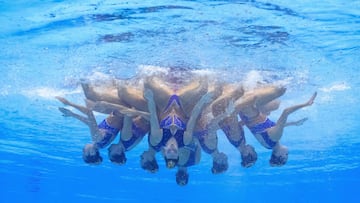OLYMPIC GAMES | ARTISTIC SWIMMING
What is the difference between artistic swimming and synchronized swimming?
The attributes of grace, agility, choreography and strength take over Paris’ Olympic pool as the water dancers take a perfectly timed splash.

Synchronization is everything when it comes to artistic swimming, a discipline that once again will be appearing in the Olympic Games. Actually, that first statement is not entirely true.
Artistic swimming, yes, this is the formal name for what is still often referred to as synchronized swimming, is so much more. It ‘combines technical perfection, synchronisation, choreography, artistry and expressive power,’ to take the official Olympics description.
It was back in the Games of 1984 in Los Angeles when artistic swimming first made an appearance under the five coloured rings. The competition has been tweaked along the way but since the turn of the century it has seen a consistent format, with both the duet and team event. There are two routines accompanied with music - which is made possible thanks to clever underwater speakers - the first being the ‘technical’ routine, with designated moves and shorter time limit, and the ‘free’ routine, which is open to creativity and imagination.
Paris 2024: artistic swimming schedule:
Monday, August 5
1:30 p.m. ET: Team: Technical Routine
Tuesday, August 6
1:30 p.m. ET: Team: Free Routine
Wednesday, August 7
1:30 p.m. ET: Team: Acrobatic Routine (Final)
Friday, August 9
1:30 p.m. ET: Duet: Technical Routine
Saturday, August 10
1:30 p.m. ET: Duet: Free Routine (Final)
How can I watch the Paris 2024 Olympic artistic swimming?
The artistic swimming competitions are being shown on E!, NBC, and Peacock. Check out our full TV guide on the event, which includes a free viewing option.
The Olympic Aquatics Centre is hosting the artistic swimming competition of these Paris Games, which runs from Monday, August 5 to Saturday, August 10. The first medals will be awarded on Wednesday, August 7. Here’s some more information that may interest you.
Artistic swimming: technical or free routine?
The ‘free’ test has a duration of three to four minutes, is performed to music and the scoring is based on difficulty, technique and choreography.
How does scoring work in artistic swimming?
In the free routine, a panel of judges decides on a score based on execution, synchronization and difficulty. Another panel scores on choreography, musical interpretation and presentation. The third and last panel scores for difficulty.
As for penalties, one point is subtracted for exceeding the time limit and two for touching the bottom of the pool. Yes, when the swimmers fire up above the surface it’s all water-generated!
Here’s AS USA’s very own Reem Abdalazeem giving you a little demonstration:
What are the differences with the technical routine?
As its name suggest, in the free routine there is more freedom in relation to the creation of the choreography and there is no need to perform any compulsory movements. But for that same reason, it may be more difficult than the technical routine (which requires five designated moves), as a high level of creativity and mastery must be shown.
What are the rules of the free routine in artistic swimming?
Swimmers are not permitted to wear transparent clothing in competition and they are not allowed to be out of the water for more than 10 seconds.
In addition to that, as mentioned above, athletes will be penalised if they touch the bottom or the edges of the pool. These measures apply to both the free routine and the technical routine.






